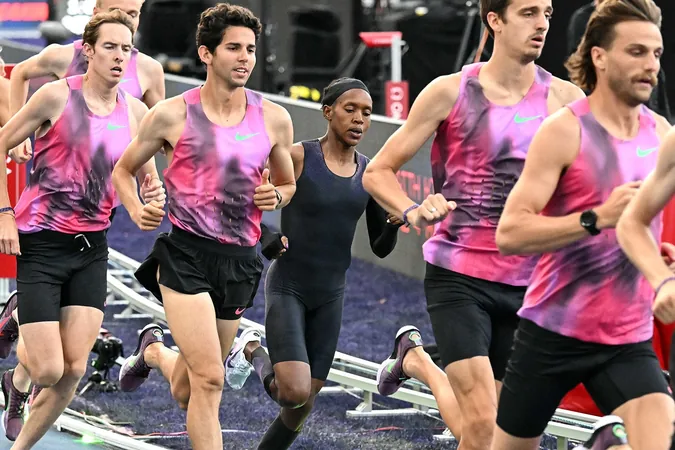
Faith Kipyegon’s Attempt at Breaking the Sub-Four Minute Mile: A Lessons Learned Experience
2025-06-28
Author: Jia
The Unprecedented Challenge
On Thursday in Paris, Faith Kipyegon aimed to make history by becoming the first woman to run a mile in under four minutes. This ambitious attempt, initially lauded as a landmark moment for women's athletics, ultimately fell short. However, calling it a failure misses the point; instead, it reveals how hype, marketing, and misunderstanding can skew perceptions in sports.
The Science Behind the Attempt
Back in February, researchers estimated Kipyegon could potentially complete a mile in 3:59.37 with optimal conditions and flawless pacing. This involved best-case scenarios and an assumption that she would be in peak form, akin to her record-setting 2023 performance of 4:07.64. While the study's authors acknowledged its limitations, the excitement surrounding the potential was infectious.
Media Hype vs. Reality
What followed was a Nike-sponsored event that spun a narrative suggesting Kipyegon was on the brink of breaking the elusive barrier. However, the marketing blitz created a false sense of expectation, as if she was already capable of a sub-four-minute mile. A more conservative analysis, even from a Nike scientist, acknowledged the challenges—yet this message was buried under the fanfare of commercial promotion.
A Closer Look at the Results
When Kipyegon ultimately clocked in 1.2 seconds below her personal best but fell over six seconds short of the sub-four-minute mark, it was a stark reminder of the gap she still faced. In elite racing, where victory is often measured in fractions of a second, this isn't a mere near-miss—it highlights the mountain she was attempting to scale.
The Challenge of Improvement
Cutting down from 4:07.64 to under four minutes isn't just a small leap; it’s over a 3% improvement—a daunting task in distance running where even marginal gains are hard-earned. Kipyegon is already at the limits of human performance, having honed her skills since her teenage years with the best training and coaching available.
Public Expectations and the Role of Science
With the media's narrative suggesting science would enable Kipyegon to achieve the 'impossible,' her failed bid invites questions about the scientists' accuracy. While expectations had been inflated, those in the scientific community were aware of the realistic odds. This miscommunication can breed distrust in scientific claims, especially when marketing glosses over the nuanced reality.
The Implications of Male Pacers
Adding another layer to this complex narrative, Kipyegon’s attempt was supported by a team of male pacers, raising questions about the implications of their involvement. While this choice stemmed from physiological advantages, it sends a mixed message about female athletes needing male support to achieve greatness, a narrative that undermines their achievements.
The Challenge of Framing Achievements
Nike's focus on Kipyegon as a representative figure for all women has created a narrative that can feel patronizing. When marketed as 'brave' for simply attempting what was likely out of reach, it risks overshadowing her genuine accomplishments, which stand independent of this ambitious attempt. The contrast between her best personal performance and the marketing messaging raises essential questions about how women's sports are represented.
Conclusion: Redefining Progress in Women's Sports
Ultimately, Kipyegon’s attempt was not just about her talent; it became a testament to corporate interest and marketing narratives. It poses a thought-provoking question: which moment truly inspires? Seeing Kipyegon finish strong in her personal best or watching her struggle to catch pacing set by men? For authentic representation and respect for women's athletics, we might want to celebrate the former.



 Brasil (PT)
Brasil (PT)
 Canada (EN)
Canada (EN)
 Chile (ES)
Chile (ES)
 Česko (CS)
Česko (CS)
 대한민국 (KO)
대한민국 (KO)
 España (ES)
España (ES)
 France (FR)
France (FR)
 Hong Kong (EN)
Hong Kong (EN)
 Italia (IT)
Italia (IT)
 日本 (JA)
日本 (JA)
 Magyarország (HU)
Magyarország (HU)
 Norge (NO)
Norge (NO)
 Polska (PL)
Polska (PL)
 Schweiz (DE)
Schweiz (DE)
 Singapore (EN)
Singapore (EN)
 Sverige (SV)
Sverige (SV)
 Suomi (FI)
Suomi (FI)
 Türkiye (TR)
Türkiye (TR)
 الإمارات العربية المتحدة (AR)
الإمارات العربية المتحدة (AR)